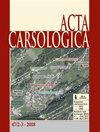硫酸溶洞中的地下水稀释和流动条件:弗拉萨西(意大利)案例研究
IF 1.1
4区 地球科学
Q4 GEOSCIENCES, MULTIDISCIPLINARY
引用次数: 0
摘要
本研究分析了富含氧气的淡水补给对弗拉萨西岩洞含硫地下水的稀释过程及其对硫酸岩浆生成和形态形成的影响。通过长达一年的监测和地下水位测量,介绍了地下水的排水模式和化学物理特性的季节性变化。从岩溶表面渗入的水流影响了硫化物地下水参数,反映了季节性流星周期。相反,代表当地基本水位的森蒂诺河仅对洞穴最外部的地下水产生直接影响。水位测量结果表明,由于岩溶化程度较高,水力梯度较低(约为 3‰),而且根据排水方向的不同,渗透率也存在一些差异。大多数洞穴水池在地表是孤立的,通过水下通道网络相互连接。在目前的条件下,大部分洞穴的硫化水上方形成了重碳酸盐水表层,它阻碍了释放出的酸性气体对水下的腐蚀。相反,残留石膏沉积物的分布和上部古老洞穴的腐蚀性壁面特征表明,在洞穴历史的某些时期,硫酸水和洞穴大气之间存在较大的界面。在这里,酸性气体(CO2 和 H2S)的释放以及 H2S 氧化产生的 H2SO4 造成了广泛的地下腐蚀,从而极大地促进了形态的形成。这些残留形态与活动过程之间的比较表明,洞穴的形态形成是随着时间的推移而演变的,受到水动力条件的影响,反过来又取决于整个岩溶地区的总体形态和水文地质环境。本文章由计算机程序翻译,如有差异,请以英文原文为准。
Groundwater dilution and flow conditions in sulfuric acid caves: the case study of Frasassi (Italy)
This study analyzes the dilution process of the sulfidic groundwater in the Frasassi caves due to the recharge of O2-rich freshwater and its influence on the sulfuric acid speleogenesis and morphogenesis. The drainage pattern and the seasonal changes of the chemo-physical characteristics of the groundwater through a year-long monitoring and the measurements of the groundwater levels are presented. The inflow of water infiltrating from the karst surface influenced the sulfidic groundwater parameters, reflecting the seasonal meteoric cycle. On the contrary, the Sentino River, which represents the local base level, directly influenced the groundwater only in the most external part of the cave. The water level measurements evidenced a low hydraulic gradient (~3‰), due to the high karstification, and also some differences in the permeability depending on the drainage direction. Most cave pools are isolated on the surface and connected to each other through a network of submerged passages. In the present conditions, a surface layer of bicarbonate water forms above the sulfidic water in a large part of the cave, where it impedes subaerial corrosion by released acidic gases. Conversely, the distribution of residual gypsum deposits and corrosional wall features in the upper old cave levels demonstrate that large interfaces between sulfidic water and cave atmosphere existed during some periods of the cave history. Here, the release of acidic gases (CO2 and H2S) and the production of H2SO4 from H2S oxidation caused the widespread subaerial corrosion which significantly contributed to the morphogenesis. The comparison between these residual morphologies and the active processes shows that morphogenesis in the cave has evolved through time, influenced by hydrodynamic conditions, in turn depending on the general morphological and hydrogeological setting of the whole karst area.
求助全文
通过发布文献求助,成功后即可免费获取论文全文。
去求助
来源期刊

Acta Carsologica
地学-地球科学综合
CiteScore
1.50
自引率
14.30%
发文量
0
审稿时长
>12 weeks
期刊介绍:
Karst areas occupy 10-20 % of ice-free land. Dissolution of rock by natural waters has given rise to specific landscape and underground. Karst surface features and caves have attracted man''s curiosity since the dawn of humanity and have been a focus to scientific studies since more than half of millennia.
Acta Carsologica publishes original research papers and reviews, letters, essays and reports covering topics related to specific of karst areas. These comprise, but are not limited to karst geology, hydrology, and geomorphology, speleology, hydrogeology, biospeleology and history of karst science.
 求助内容:
求助内容: 应助结果提醒方式:
应助结果提醒方式:


